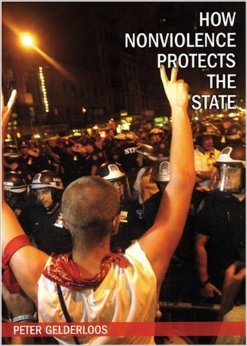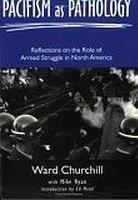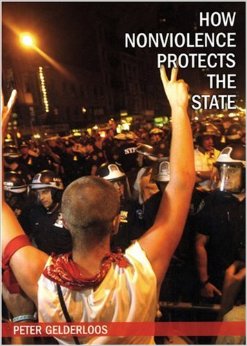Negating Nonviolence: A Review Essay

How Nonviolence Protects the State
By Peter Gelderloos
South End Press, 2007, 182 pages, $10
The Logic of Political Violence:
Lessons in Reform and Revolution
By Craig Rosebraugh
Arissa Media Group, 2003, 288 pages,
$17.95
Pacifism as Pathology:
Reflections on the Role of Armed Struggle in North America
By Ward Churchill
Arbeiter Ring Publishing, 1998, 176 pages, $9.95
When Ward Churchill chose to liken a political ideology he disagrees with to mental disorder, another nail in the coffin of constructive debate was hammered down. Not that his 1986 essay “Pacifism as Pathology” hasn’t generated its fair share of spirited conversation. Indeed, its re-publication in 1998, complete with references to the Black Liberation Army, Weather Underground, and other clandestine, armed groups, sparked a series of responses from across the political spectrum. It is doubtful, however, that the dialogue was set on a positive trajectory toward building a stronger revolutionary movement based on lessons from the recent past.
Churchill bases the terms of debate upon the unsubstantiated claim that “nonviolent political action has become axiomatic and all but universal among the more progressive elements of contemporary mainstream North America.” Here, he confuses committed pacifists with sectors of the movement that have chosen, tactically or otherwise, to not engage in violence. Though they may not currently be engaged in armed struggle, Trotskyists who believe in the urgent need for popular education, members of the CP-USA who veer towards electoral politics, or social democrats who rail against the violence of the oppressed but fall short in their own criticisms of state-sponsored “low-intensity” conflict, are hardly appropriate representatives of the pacifist left.
If one adds up all the activists from WRL, Fellowship of Reconciliation, Pax Christi, and their various affiliates with members of traditional peace churches and assorted local nonviolent action groups, one can hardly assert that this hodgepodge assembly exercises hegemonic control over U.S. progressive thought. Indeed, even to lump conscientious advocates of nonviolent direct action with ideologically purist pacifists is a leap one must be particularly cautious of, as noted by Training for Change founder George Lakey in his 2001 essay challenging Churchill, “Nonviolent Action as the Sword That Heals.”
 Though Churchill ends up writing forcefully of the desire to build a nonviolent and cooperative world through a diversity of tactics and strategies and an accompanying essay in the book concludes with a quote from Barbara Deming on the need for symbiosis among radicals of all stripes, the basic premise of the original essay is that nonviolent activists base our worldview on the idea that everything bad in the world would get better if only nobody got physically hurt. Pacifist ideology, Churchill suggests, contends that nonconfrontational forms of struggle will positively dictate the reactions of an oppressive and repressive state apparatus. These claims, however, are not backed up by any serious review of theory or history. A few anecdotal incidents of short-sighted and unstrategic moments of movement madness may condemn some pacifists as narrow-minded utopians or sectarian apologists for the most minor of reforms. But surely, there are just as many anecdotes of armed struggle advocates engaging in similarly limited thinking.
Though Churchill ends up writing forcefully of the desire to build a nonviolent and cooperative world through a diversity of tactics and strategies and an accompanying essay in the book concludes with a quote from Barbara Deming on the need for symbiosis among radicals of all stripes, the basic premise of the original essay is that nonviolent activists base our worldview on the idea that everything bad in the world would get better if only nobody got physically hurt. Pacifist ideology, Churchill suggests, contends that nonconfrontational forms of struggle will positively dictate the reactions of an oppressive and repressive state apparatus. These claims, however, are not backed up by any serious review of theory or history. A few anecdotal incidents of short-sighted and unstrategic moments of movement madness may condemn some pacifists as narrow-minded utopians or sectarian apologists for the most minor of reforms. But surely, there are just as many anecdotes of armed struggle advocates engaging in similarly limited thinking.
Reform vs. Revolution
A more nuanced and reflective analysis can be found in Craig Rosebraugh’s The Logic of Political Violence. Rosebraugh reviews lessons from the U.S. civil rights and anti-Vietnam war movements; the Algerian, Vietnamese, and Cuban revolutions; and uprisings in Ireland and among Jews throughout Europe during the Second World War. Rather than begin with polemics against pacifist thought, the author introduces us to the assumptions he felt were imposed on him during his process of radicalization in the 1990s United States.
He centers his arguments on the failures of reform and the need for revolution, rather than focusing on an apparent (or alleged) dichotomy between violence and nonviolence. Therefore, his historically detailed and insightful chapter on civil rights correctly concludes that it was the reformist nature of much of this movement that caused its inability to “obtain true equality” for African-Americans. Rosebraugh does cite some victories gained by groups committed to nonviolent means. He also recounts the power of figures such as Robert F. Williams, the Monroe, N.C. NAACP leader famous for his early advocacy of armed self-defense (and later, revolutionary nationalism) for Blacks/New Afrikans.
One strength of Logic is Rosebraugh’s formulation of a five-point set of “Rules for the Game of Social and Political Change in the U.S.,” acknowledging unspoken and underlying assumptions at play. This schematic matches an extremely narrow, dogmatic version of nonviolent tactics with a purely reformist series of goals. These rules then, identifying a really-existing, problematic version of pacifism (not Gandhi’s, King’s, etc.), is what Logic critiques.
Though his central conclusion—that philosophical nonviolence is primarily a tool of the reformist middle class—might anger some pacifists, I found the series of cases and questions Rosebraugh takes us through to be essential to any student of contemporary social change. His closing chapters on political violence and on the application of historical lessons to current U.S. struggles is complete with citations from King and Malcolm X and from Frantz Fanon and Zambia’s more nonviolence-oriented Kenneth Kaunda. Rosebraugh’s assertion that “no one in their right mind wants to use or resort to violence at any time during their lives,” but that violence is often necessary when making revolution, should be appropriately challenging to champions of armed struggle and nonviolence alike.
 It is a sad step backward that South End Press decided to reprint the apparently intentionally simplistic How Nonviolence Protects the State by Peter Gelderloos. With chapter headings positing how nonviolence is ineffective, racist, statist, patriarchal, delusional, etc., he begins right where Churchill left off, bemoaning the hegemonic control that nonviolent activists have over the U.S. left.
It is a sad step backward that South End Press decided to reprint the apparently intentionally simplistic How Nonviolence Protects the State by Peter Gelderloos. With chapter headings positing how nonviolence is ineffective, racist, statist, patriarchal, delusional, etc., he begins right where Churchill left off, bemoaning the hegemonic control that nonviolent activists have over the U.S. left.
As if no new thinking or dialogue had taken place since the publication of Churchill’s essay, Gelderloos uses the neocolonial nature of postindependence India as proof of the ineffectiveness of nonviolence. He quotes liberally and out of context from the writings of Weather political prisoner David Gilbert to prove that nonviolence is inherently racist, substantially missing the subtleties about the nature of both race and tactics included in Gilbert’s reflections. He correctly cites the FBI’s Counter Intelligence Program as proof that the state will use any means at its disposal to dismantle and destroy revolutionary uprisings, but incorrectly infers that keeping movements pacifist—as opposed to keeping people passive—was a COINTELPRO goal.
Which Left?
He suggests that the left was shocked in 2004 at news reports revealing police agencies’ spying on peace groups (surprisingly spotlighted by The New York Times), but that far less attention was paid to the government’s ongoing repression of the Puerto Rican movement, as evidenced by reaction to the 2005 FBI murder of independentista Filiberto Ojeda Rios. This writer wonders what left Gelderloos was moving in—as only a few, small responses were made to the former reports, whereas masses of Puerto Ricans and those in solidarity filled venues throughout the island and the United States in the days and weeks that followed Filiberto’s assassination. Yes, the mainstream media did not give the same attention to the Puerto Rican plight, but are we to assume from this that Gelderloos, like George W. Bush, sees The New York Times as a tool of the left?!
One off-handed comment in Gelderloos’ chapter on terminology is worth further exploration. He posits that it is difficult to distinguish between revolutionary and non-revolutionary pacifists, because too many of us do not make these distinctions clear in the course of our work. “Shared commitment to nonviolence,” Gelderloss suggests, “and not shared commitment to a revolutionary goal, is the chief criterion” of pacifists in deciding whom to work with and what issues to work on. Indeed, until those of us committed to revolutionary nonviolence articulate a sharper understanding of the ideology we espouse and the practices we’re willing to sanction or engage in, we will be open to these and related criticisms.
The time has come for new thinking and for renewed revolutionary action within the borders of the U.S. empire. It is up to all would-be revolutionaries to base our praxis not on name-calling or rhetorical flourishes based on leftover debates from generations past. We must make our own careful review of history, an honest assessment of the pros and cons of the diversity of strategies and tactics and philosophies used to get us to this point. And then we must move forward.
